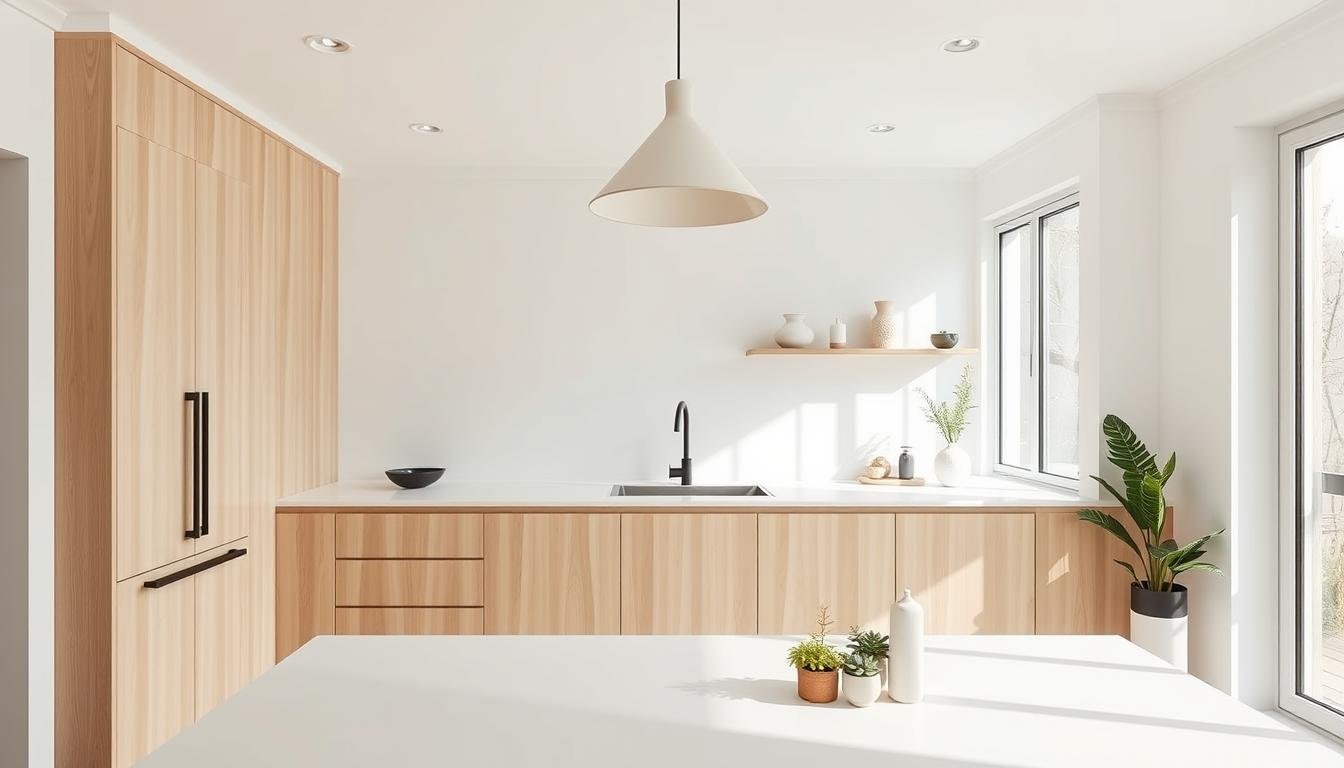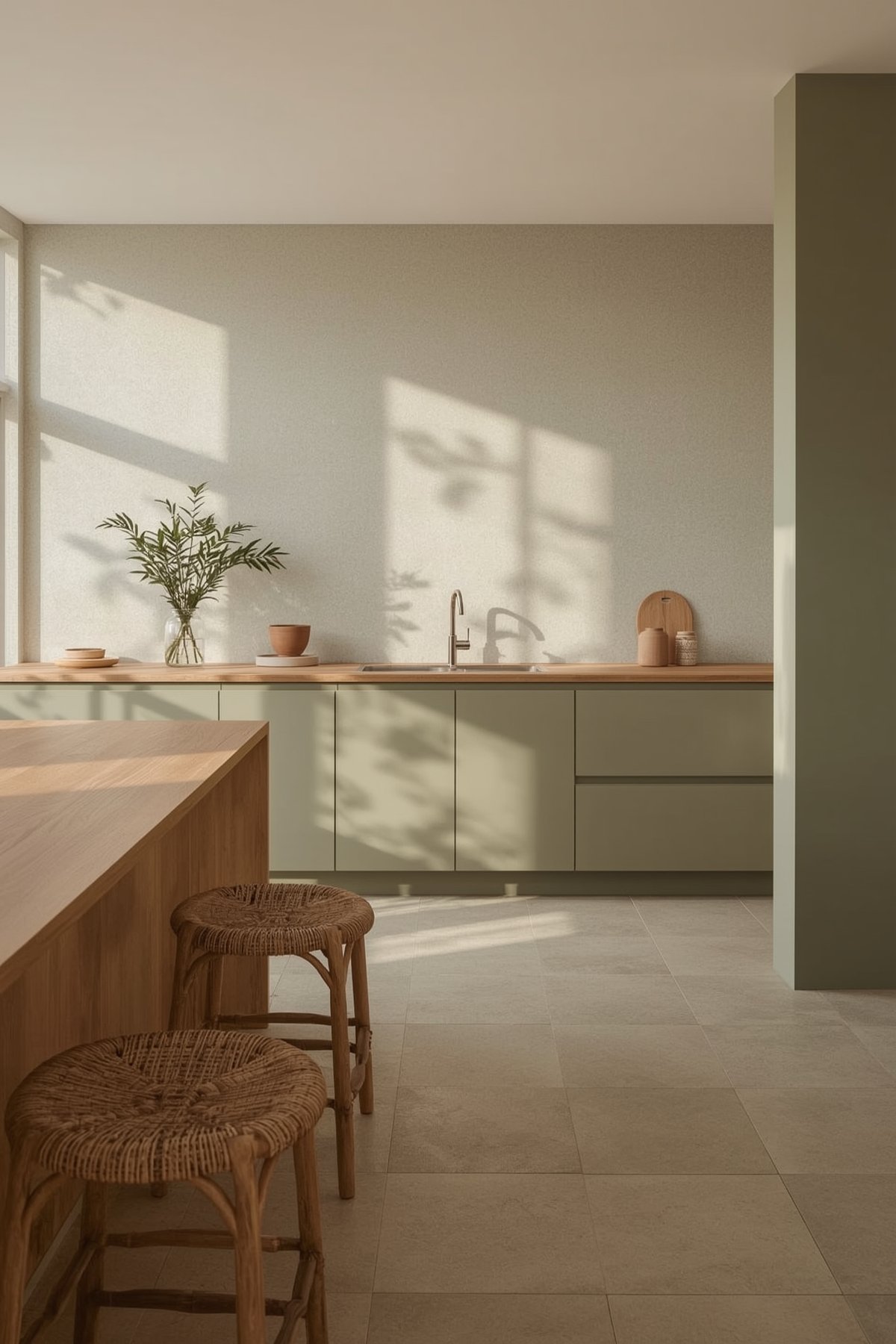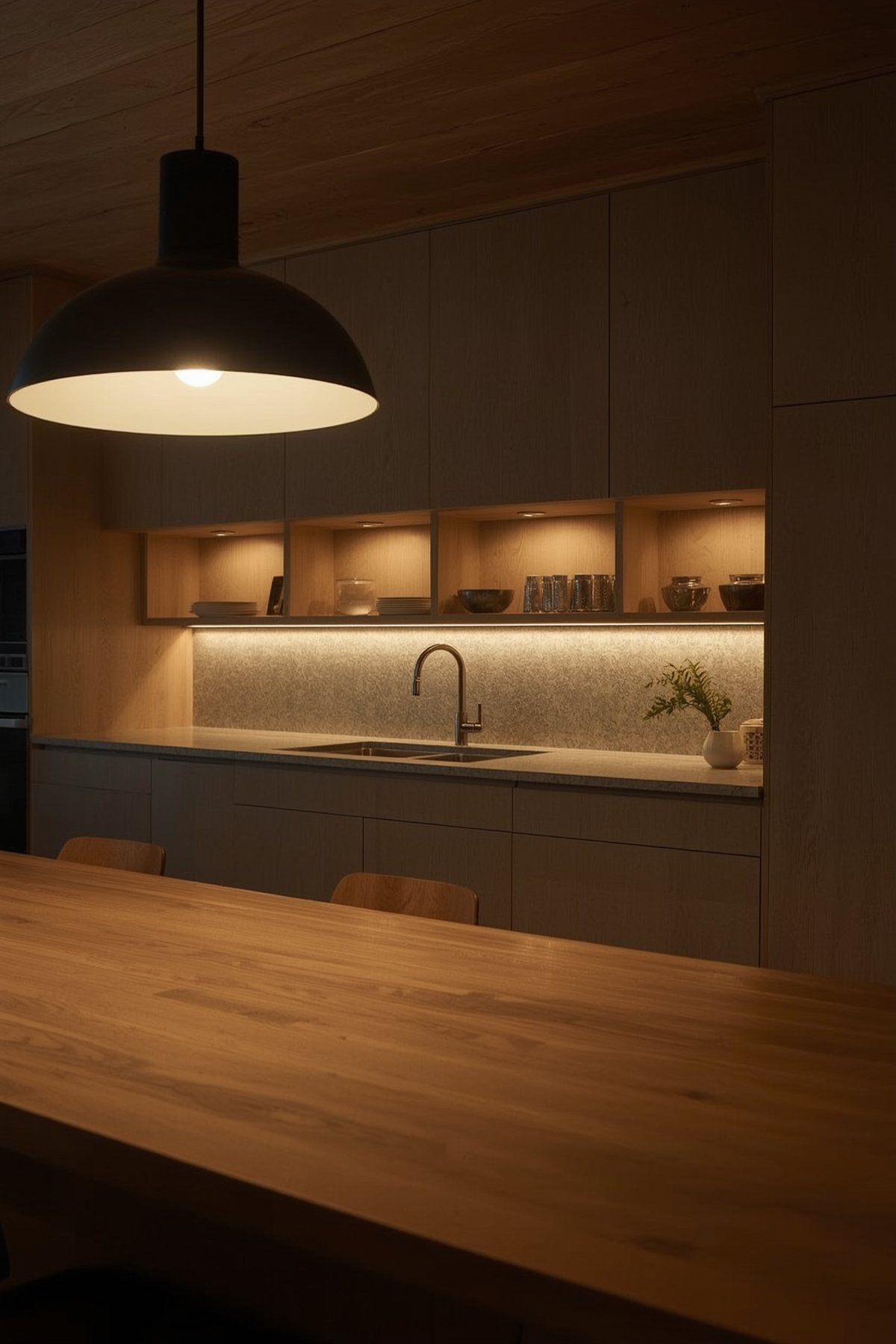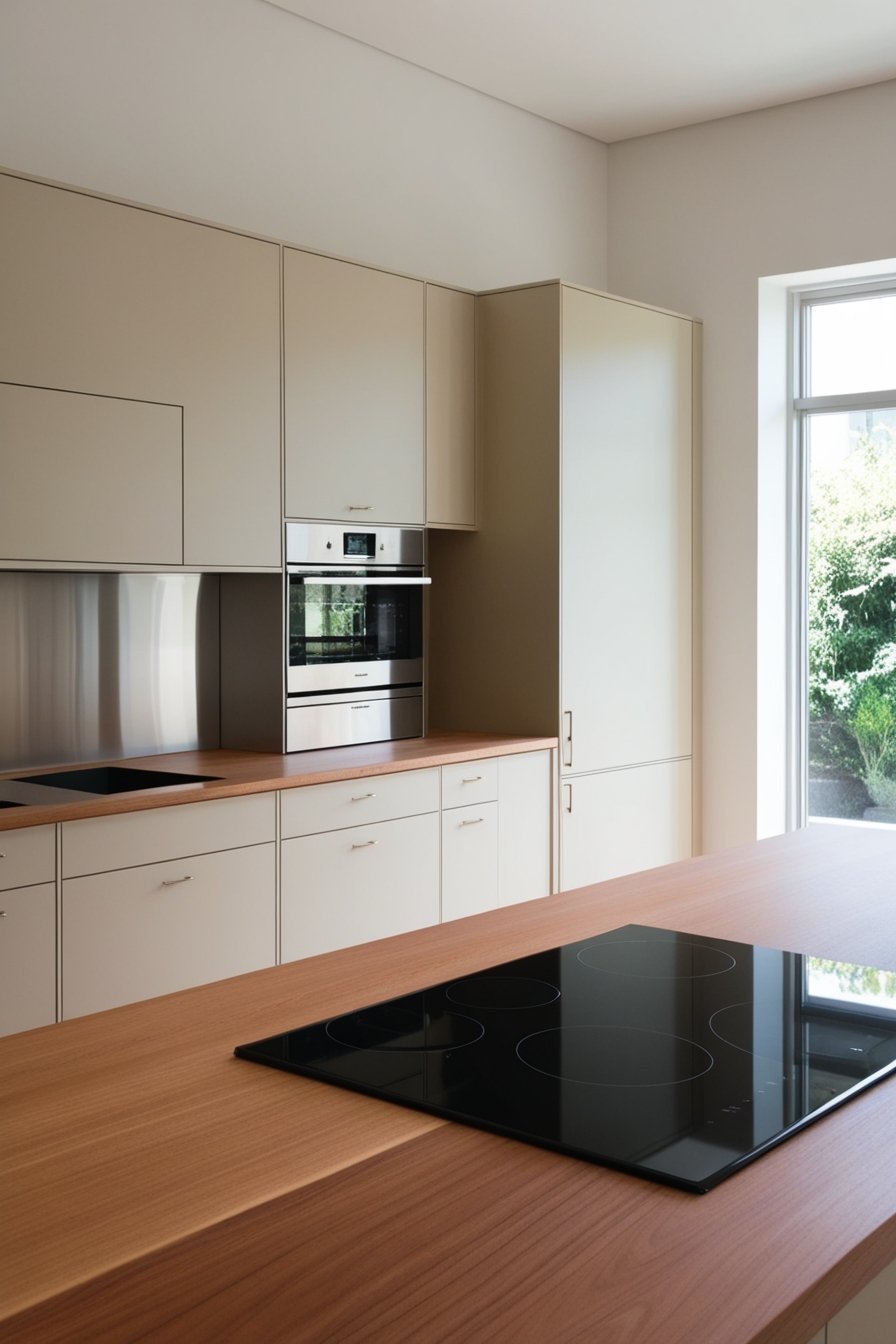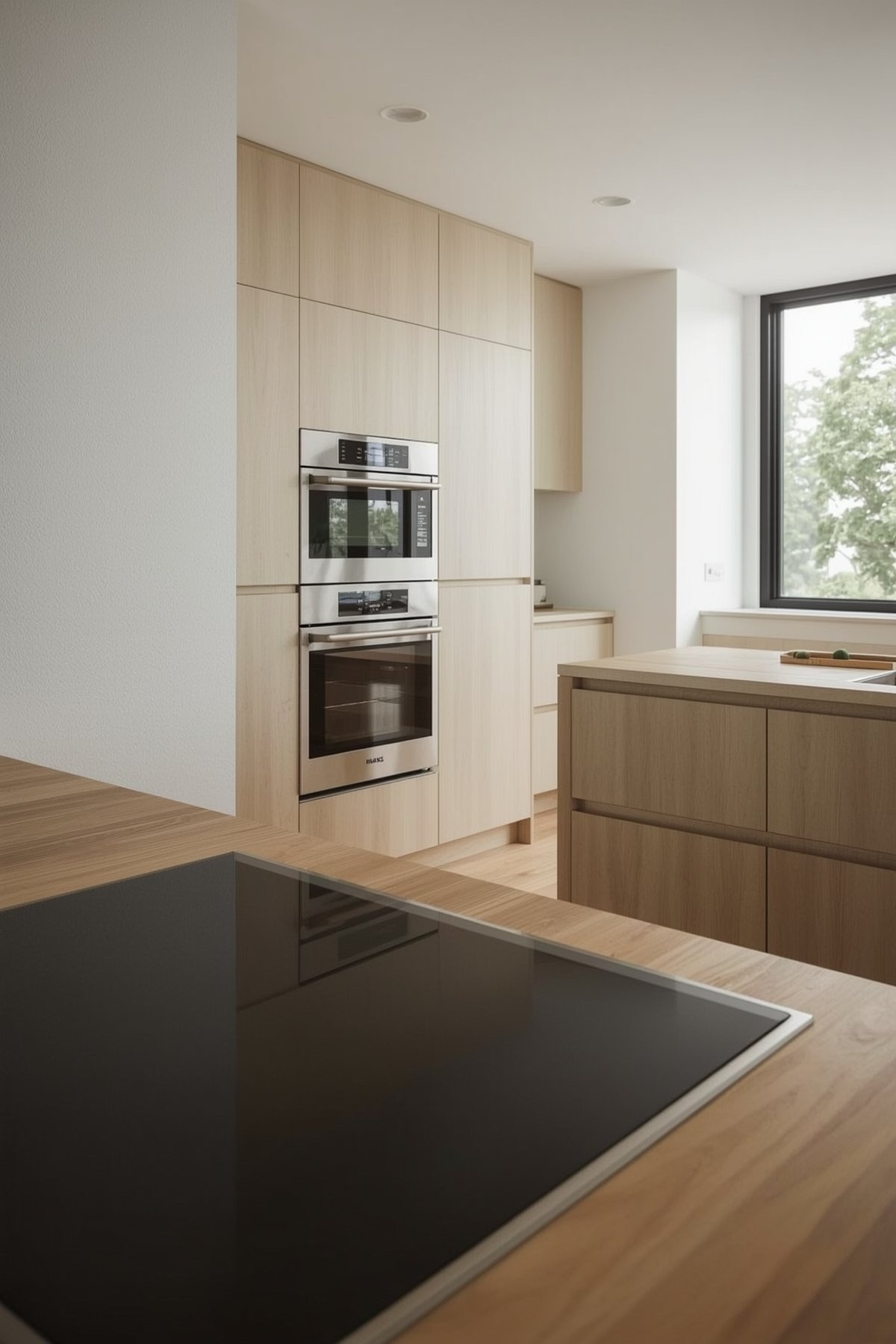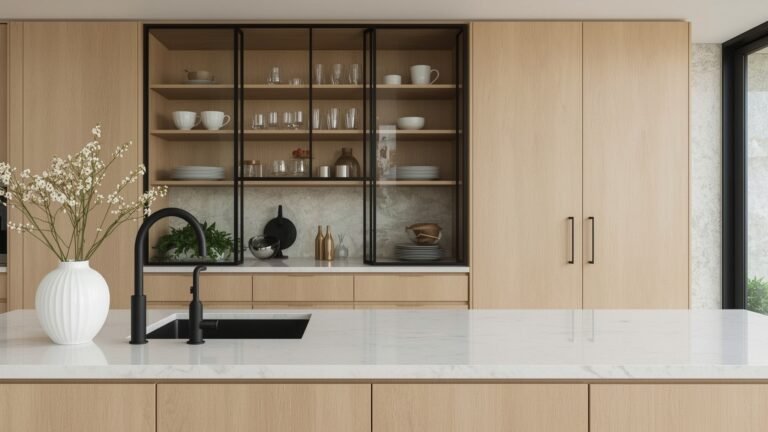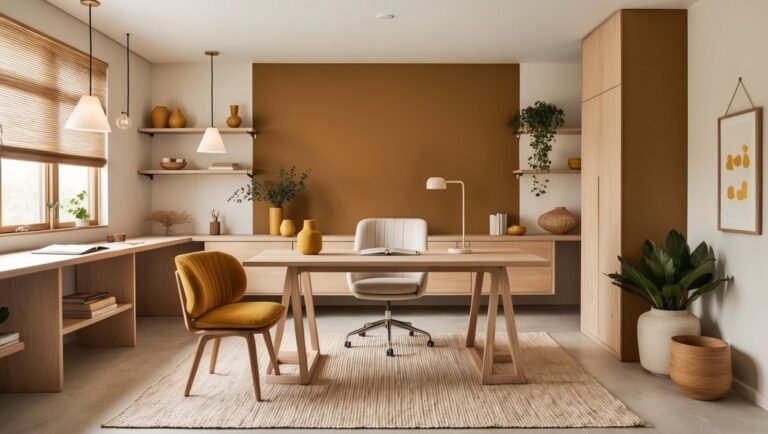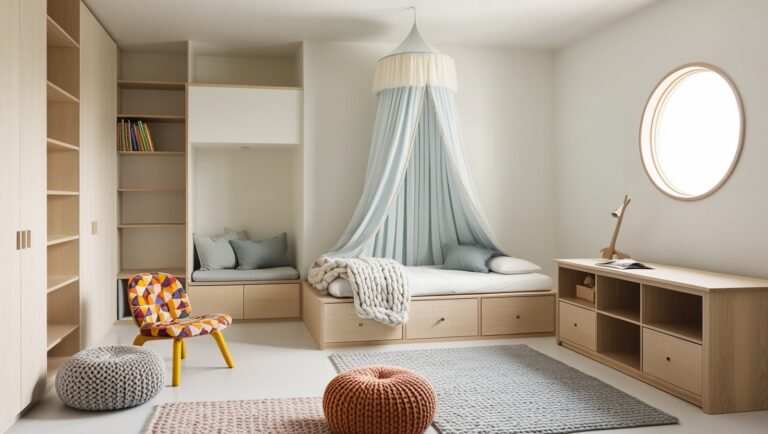Japandi Kitchen Design: Blending Simplicity, Nature, and Efficiency
Discover how Japandi kitchen design effortlessly combines minimalist simplicity with natural elements to create a functional and serene culinary space. This fusion of Japanese and Scandinavian aesthetics emphasizes clean lines, warm wood textures, and smart storage solutions, perfect for modern homes seeking calm and efficiency.
Explore key tips to transform your kitchen into a stylish, clutter-free sanctuary that celebrates nature and purposeful design.
Key Takeaways
- Japandi design combines Japanese and Scandinavian aesthetics for a unique look.
- Emphasis on minimalism and natural materials creates a serene ambiance.
- Functional layouts make cooking efficient and enjoyable.
- Japandi kitchens are ideal for those seeking a calm culinary space.
- Incorporating natural elements and clean lines is key to Japandi design.
The Essence of Japandi Design Philosophy
Exploring Japandi design shows us a mix of Eastern and Western ideas. It creates a special look for kitchens. This design isn’t just about looks; it’s about making cooking smooth.
Origins of Japandi: Where East Meets North
Japandi mixes Japanese and Scandinavian design. It takes Japanese simplicity and natural materials. Then, it adds Scandinavian functionality and simplicity. This mix makes a design that’s both lovely and useful.
Core Principles: Simplicity, Nature, and Functionality
Japandi design focuses on simplicity, nature, and functionality. It removes the extra to show the space’s true self. It uses natural materials for warmth and makes sure each part has a role. This makes a ergonomic space that’s cozy and efficient.
Why Japandi Works Perfectly for Kitchen Spaces
Japandi is great for kitchens because of its focus on simplicity, natural materials, and function. It keeps things tidy, adds natural textures, and makes sure everything is both pretty and practical. This leads to a kitchen that looks good and works well.
Minimalist Design Principles for Modern Kitchens
Minimalist design can make your kitchen calm and efficient. It’s all about keeping things simple and useful. This way, your kitchen looks great and works well.
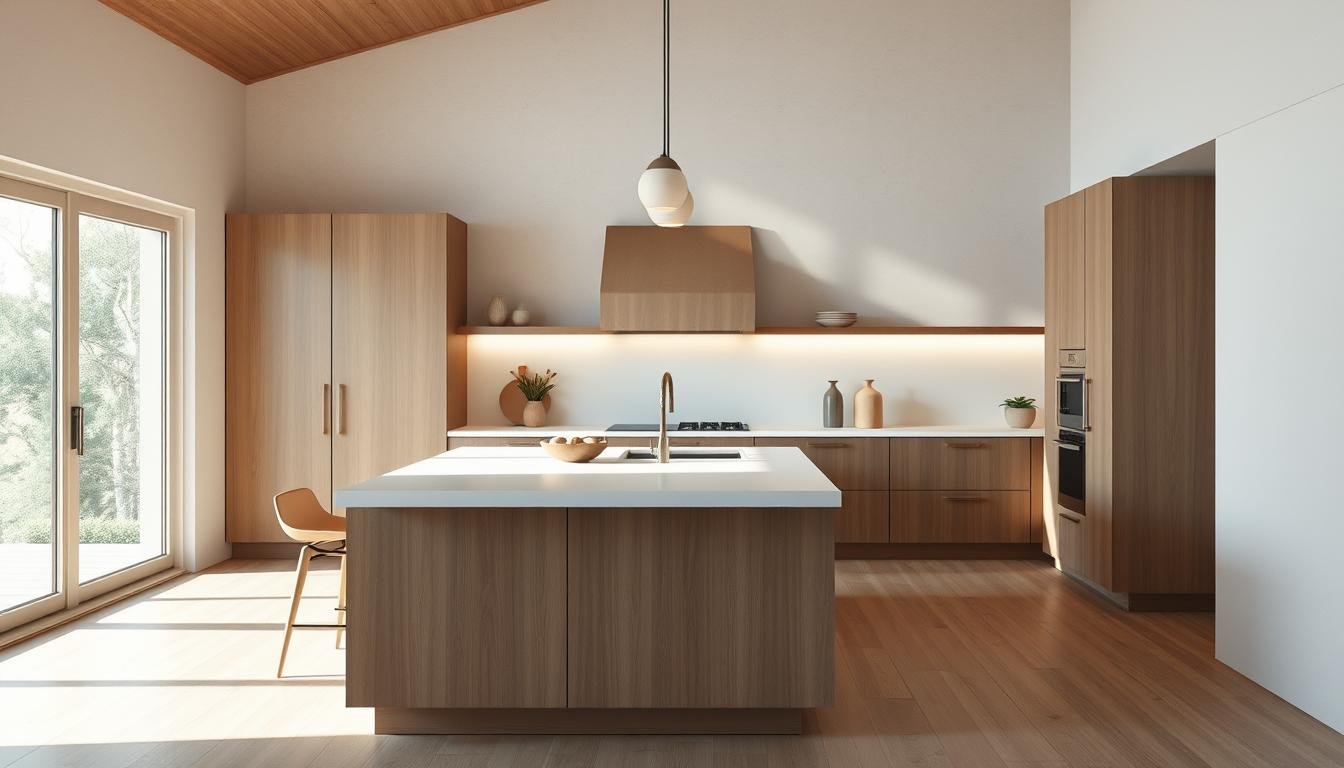
Less is More: Decluttering Your Culinary Space
Start by getting rid of things you don’t need. Keep only the most important appliances and tools. This makes your kitchen look better and work better too.
Intentional Design: Purpose Behind Every Element
Every part of a minimalist kitchen has a reason. The layout and materials are chosen for their simplicity and usefulness. This makes your kitchen both practical and pretty.
The Balance Between Aesthetics and Utility
Finding the right mix of looks and function is key. Choose materials and appliances that are both useful and attractive. This way, you get an optimized kitchen that suits you and looks good.
Using these minimalist ideas, you can make a kitchen that’s beautiful and useful. It becomes the heart of your home.
Creating Truly Functional Kitchens with Japandi Influences
Japandi kitchen design is all about being functional and simple. It’s not just about how it looks. It’s about making the space work well and feel good.
The Work Triangle: Optimizing Movement
The work triangle is key in making kitchens work better. Japandi kitchens use this idea to make moving around easier. By putting the sink, stove, and fridge in a triangle, you walk less and work better.
Placing Major Appliances Strategically
Think about where to put big appliances in your work triangle. Put the sink between the stove and fridge for a smooth flow. This setup is efficient and keeps things tidy.
Countertop Workspace Planning
Having enough counter space is important for cooking and prep. Japandi kitchens aim for clean lines and no clutter. Plan your counter space well. Think about pull-out boards or retractable counters for extra room.
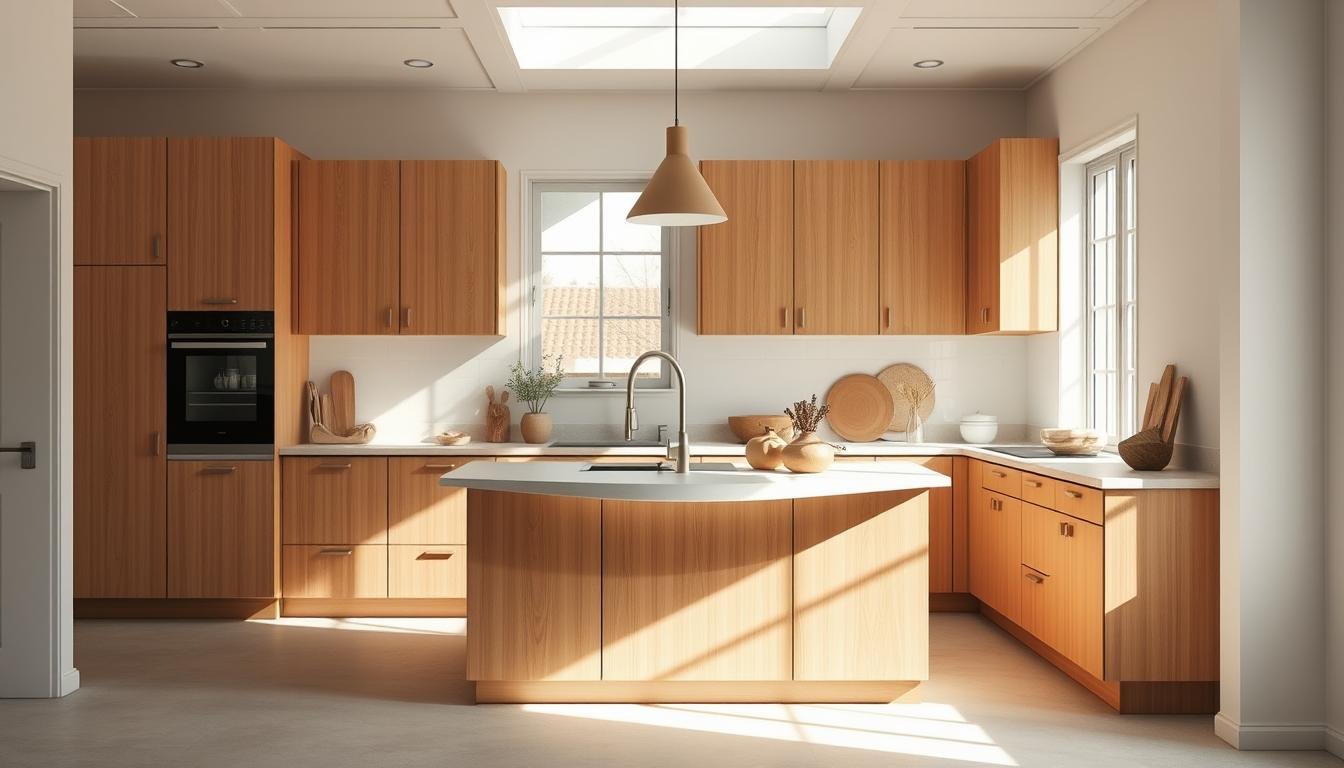
Zone Planning for Effortless Cooking
Zone planning helps make Japandi kitchens work better. Divide your kitchen into areas for cooking, prep, and storage. This makes cooking easier and more fun.
Accessibility Without Compromise
A Japandi kitchen is about looks and function. Think about storage that looks good and works well. Like hidden drawers or open shelves for things you use a lot. This mix of looks and use is what Japandi is all about.
Materials and Textures in Japandi Kitchen Design
In Japandi kitchen design, materials and textures are key. They help create a space that is simple, functional, and connected to nature.
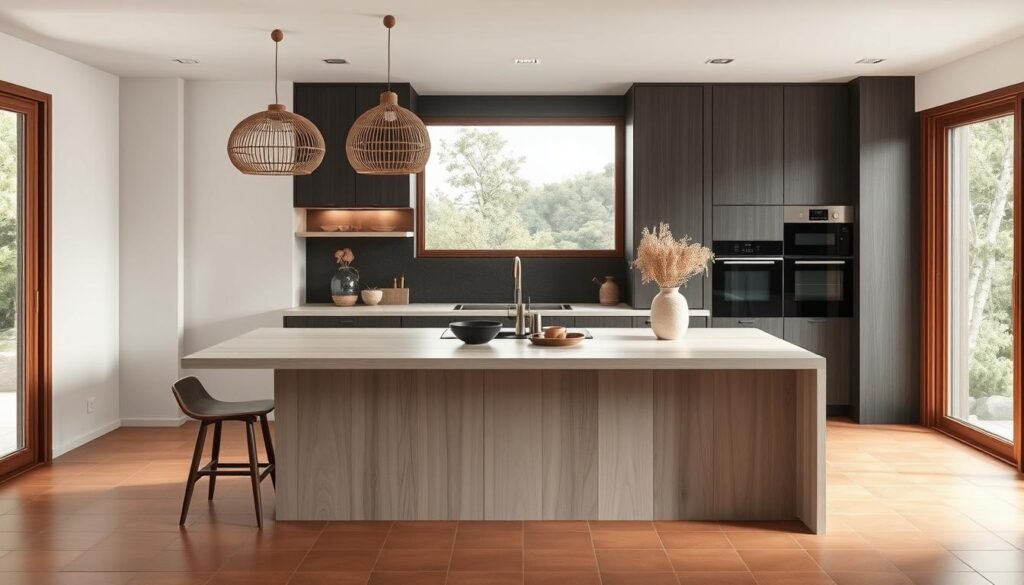
Natural wood is central to Japandi kitchen design. It adds warmth and character. Wooden elements can be used for cabinets, flooring, or accent walls.
Natural Wood Elements: The Heart of Japandi
Types of Wood That Embody Japandi Aesthetic
Oak, pine, and walnut are favorite woods. They are beautiful and durable. Each wood adds its own texture and grain, making the kitchen richer.
Finishes and Treatments
The wood’s finish is very important. A natural or matte finish keeps the wood’s organic feel.
Stone and Concrete: Adding Scandinavian Solidity
Stone and concrete add solidity and modernity. These materials are strong and ground the space.
Stone countertops make the kitchen feel luxurious. Concrete can be used for flooring or kitchen islands.
Textile Choices: Subtle Warmth and Texture
Textiles are important in Japandi kitchen design. They add warmth and texture without making the space feel cluttered.
Simple fabrics like cotton or linen are great. They can be used for curtains or table runners, adding softness to the kitchen.
Color Palettes That Embody Japandi Minimalism
Japandi minimalism uses color wisely. It makes a space that looks good and works well. This approach is not just about looks. It’s about making a practical cooking space that makes cooking better.

Neutral Foundations: Whites, Beiges, and Grays
Neutral colors are key in Japandi kitchens. Whites, beiges, and grays create a calm look. They also make the kitchen look bigger by reflecting light.
These colors are great for adding natural textures and soft colors. This makes the kitchen feel welcoming and cozy.
Accent Colors: Muted Tones and Earth Hues
Even though the base is neutral, Japandi kitchens have color. Muted and earthy tones add warmth and depth. These colors come from accessories, textiles, or special furniture pieces.
Creating Visual Harmony Through Color Balance
Getting colors right in a Japandi kitchen is important. You need to keep neutral colors in charge. Then, add accent colors carefully.
This balance makes the kitchen look good and work well. It turns the kitchen into an ergonomic space that makes cooking easier.
Innovative Storage Solutions for Clutter-Free Spaces
To keep your Japandi kitchen organized, try these smart storage ideas. Japandi kitchens use clever storage to stay tidy and functional.
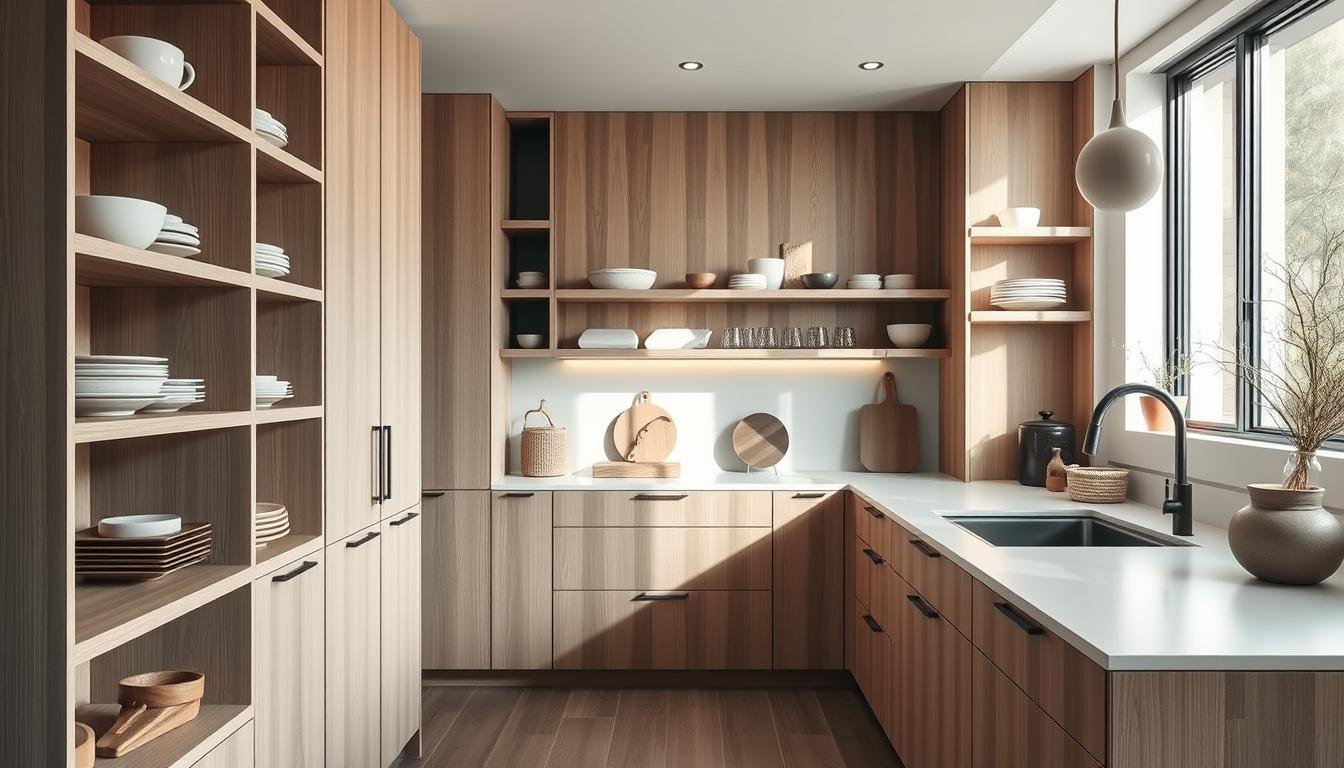
Hidden Storage: The Invisible Organization System
Hidden storage is key in Japandi design. It keeps your kitchen neat without showing clutter. This is done with smart cabinet and drawer designs.
Cabinet Design Innovations
Modern Japandi cabinets have soft-close drawers and doors. They also have pull-out shelves and spice racks. These features make your kitchen both useful and clean.
Drawer Organization Systems
Drawer organization is vital for a tidy kitchen. Use dividers, baskets, or inserts to organize utensils and tools. This keeps them hidden from view.
Open Shelving: Curated Display with Purpose
Open shelving is used in Japandi design to show off kitchenware. It adds beauty to your kitchen while keeping it simple.
Smart Solutions for Small Kitchen Spaces
In small Japandi kitchens, you need to use space wisely. Try wall-mounted shelves, foldable tables, or retractable drying racks. These ideas help make your kitchen both beautiful and practical.
With these smart storage solutions, you can make your Japandi kitchen stunning and useful.
Discover more in my Kitchen Organization Blog.
Lighting Design: Creating Atmosphere in Japandi Kitchens
In Japandi kitchens, lighting is more than just light. It’s about making a space that’s both beautiful and useful. The right lights can make the kitchen feel cozy and perfect for cooking.
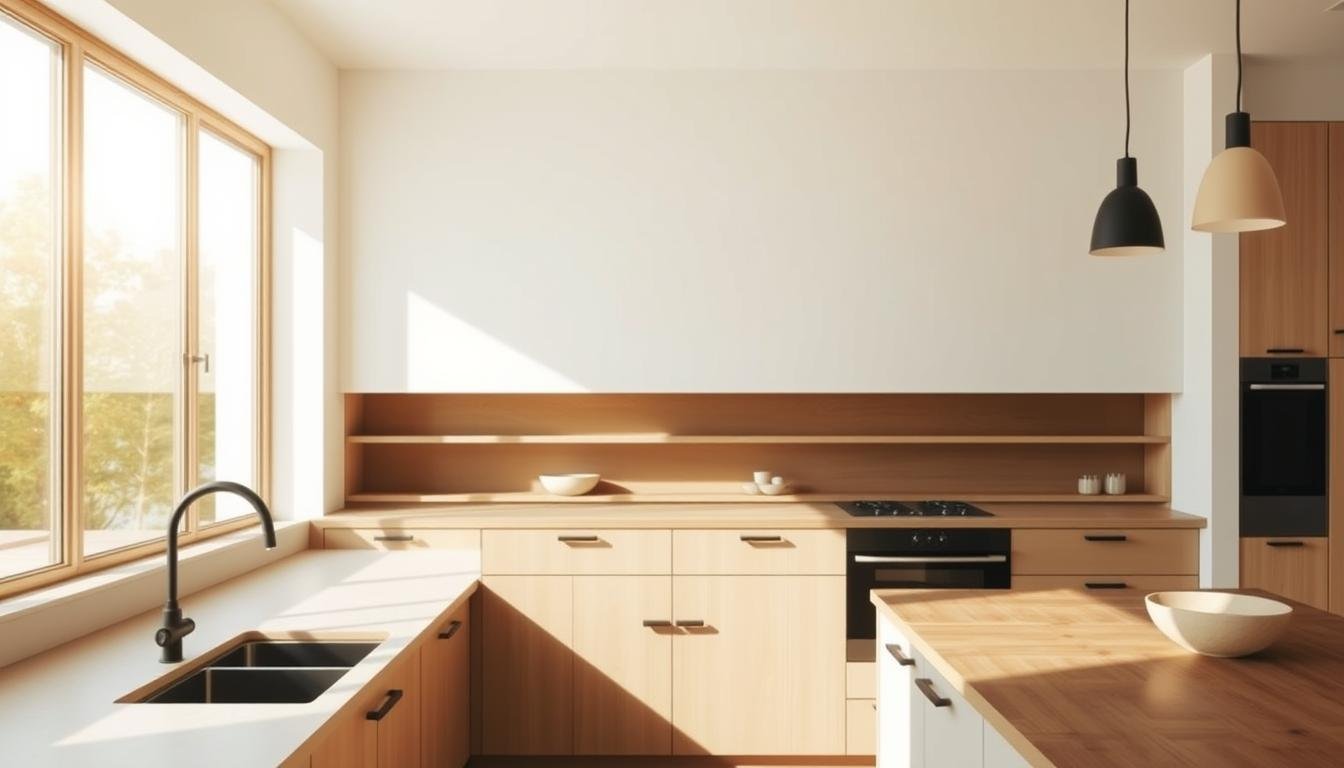
Natural Light Maximization Techniques
Getting more natural light is key in Japandi kitchens. Use sheer curtains, mirrors, and clear windows to let in more light. This makes the kitchen bright and welcoming, needing less artificial light.
Simple window treatments and strategic mirror placement help a lot. They make the kitchen brighter and feel more open.
Ambient Lighting: Setting the Mood
Ambient lighting sets the mood in Japandi kitchens. It gives a soft light that makes the space feel cozy. You can use pendant lights, recessed lights, or lights under cabinets to create a nice atmosphere.
Pendant and Recessed Lighting Options
Pendant lights add elegance, while recessed lights are more subtle. Both can make the kitchen look interesting and layered.
Under-Cabinet Illumination
Under-cabinet lights are useful and warm. They light up countertops and make the kitchen feel cozy. LED strips are great for this because they’re energy-saving and flexible.
By using natural light, ambient lighting, and under cabinet lighting, Japandi kitchens are perfect. They look great and work well, thanks to careful lighting design.
Selecting and Integrating Appliances in Minimalist Kitchens
To make a Japandi kitchen clean, pick appliances wisely. The right ones make the kitchen look good and work well.
Built-In Solutions for Seamless Aesthetics
Built-in appliances make kitchens look sleek and tidy. They fit right into the cabinets. This makes the kitchen look better and use space well.
Choosing Appliances That Complement Japandi Style
When picking appliances, think about how they look and work. Japandi style likes simple designs and natural materials. So, choose appliances that match these.
Material and Color Considerations
Go for appliances with finishes like stainless steel, matte black, or white. These colors and materials go well with Japandi kitchens.
Size and Proportion Guidelines
Make sure appliances fit your kitchen well. Big appliances can make small kitchens feel cramped. Choose sizes that work for your space.
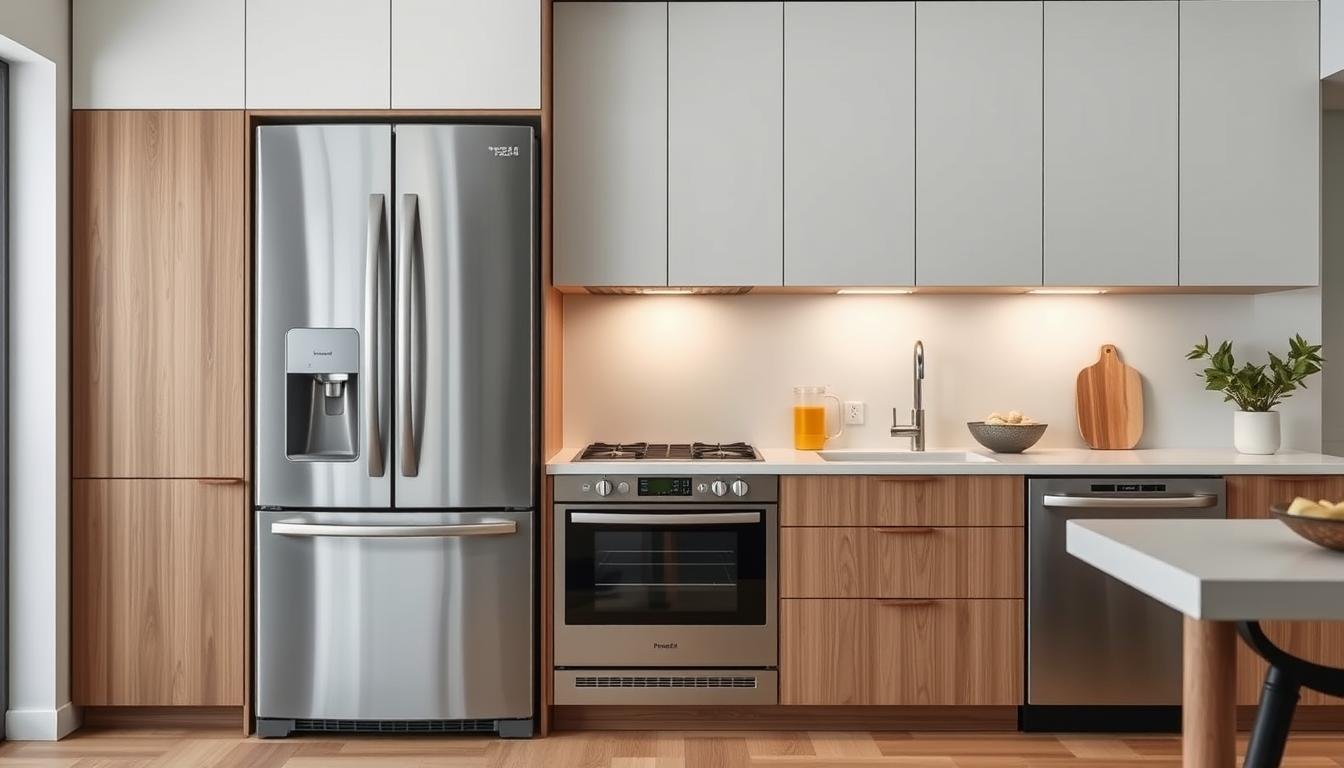
The Art of Hiding Technology in Plain Sight
In a Japandi kitchen, tech should blend in. Use panels or hide it in cabinets. This keeps the kitchen looking clean and simple.
By picking and placing appliances carefully, you can make a kitchen that’s both pretty and useful. It will show off Japandi design well.
FAQ
What is Japandi kitchen design?
Japandi kitchen design mixes Japanese and Scandinavian styles. It focuses on simplicity, function, and natural materials. This creates a calm and efficient cooking area.
How can I create a functional kitchen with Japandi influences?
For a functional Japandi kitchen, use the work triangle and zone planning. Place big appliances well and plan workspaces on countertops. Use storage that looks good and works well, like IKEA and Muji offer.
What materials are commonly used in Japandi kitchen design?
Japandi kitchens use natural materials like wood, stone, and concrete. Wood, like oak and walnut, is often chosen. Stone and concrete add a solid feel. Linen and cotton add warmth and texture.
What color palettes are characteristic of Japandi minimalism?
Japandi kitchens have neutral colors like whites, beiges, and grays. They add muted and earthy colors for balance. This makes the kitchen look good and work well.
How can I maximize storage in my Japandi kitchen?
For more storage, try hidden spots, open shelves, and smart solutions for small kitchens. The Container Store and Hafele have many options that keep your kitchen looking good.
What role does lighting play in Japandi kitchen design?
Lighting is key in Japandi kitchens. It uses natural light, ambient, and task lighting for a warm feel. Use pendant lights, recessed, and under-cabinet lights. Philips and Lutron have many options.
How can I integrate appliances into my minimalist Japandi kitchen?
Choose built-in appliances and ones that fit the Japandi style. Hide tech in your kitchen. Sub-Zero and Miele have sleek, high-quality appliances.
What are some common mistakes to avoid when designing a Japandi kitchen?
Avoid too many accessories, ignoring function, and not balancing looks with use. Stay aware of these to make a kitchen that looks and works great, following Japandi design.
The Bottom Line
Embracing Japandi design can turn your kitchen into a calm and useful place. The secret is to mix simplicity with practicality. This makes your kitchen layout efficient for cooking.
Using natural materials like wood and stone brings warmth and texture. Good storage keeps your kitchen tidy. Thoughtful lighting makes it feel welcoming.
Japandi kitchen design is not just about looks. It’s about making a space that supports both beauty and usefulness. By following the tips in this article, you can make a kitchen that looks great and makes cooking better.
Focus on a good layout and storage to make a Japandi kitchen. It will spark your cooking creativity and create special moments with loved ones.

ABOUT the AUTHOR
TOKI; INTERIOR DESIGN & lifestyle CONTENT CREATOR.
Hey there! I’m Toki—the design-obsessed brain behind Dwell Studio 24. I’m a content creator passionate about interior design, photography, and creativity, living in a 77-year-old house with my husband and our awesome three kids. I write about interior design, furniture, home topics, and my lifestyle, including travel, recipes, skincare, and daily routines. I hope to inspire your next project and lifestyle!
ABOUT the AUTHOR
TOKI; INTERIOR DESIGN & lifestyle CONTENT CREATOR.

Hey there! I’m Toki—the design-obsessed brain behind Dwell Studio 24. I’m a content creator passionate about interior design, photography, and creativity, living in a 77-year-old house with my husband and our awesome three kids. I write about interior design, furniture, home topics, and my lifestyle, including travel, recipes, skincare, and daily routines. I hope to inspire your next project and lifestyle!
ABOUT the AUTHOR
TOKI; INTERIOR DESIGN & lifestyle CONTENT CREATOR.

Hey there! I’m Toki—the design-obsessed brain behind Dwell Studio 24. I write about interior design, furniture, home topics, and my lifestyle, including travel, recipes, skincare, and daily routines. I hope to inspire your next project and lifestyle!

